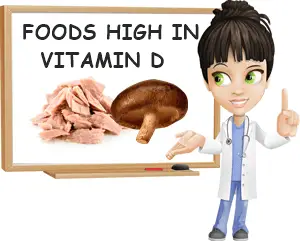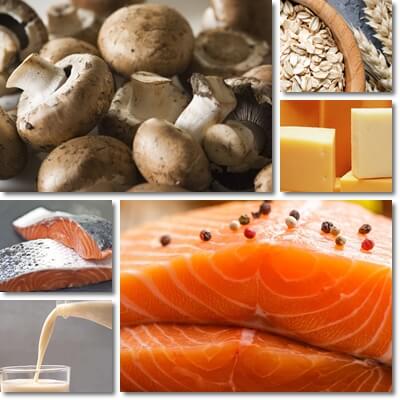Can you get all of your daily vitamin D from foods? Vitamin D is quite the elusive nutrient in the sense that it’s only found in certain foods and completely absent from others.
The interesting thing is that vitamin D is absent from common foods that most people eat on a daily basis which can explain why so many people are diagnosed with a vitamin D deficiency.
The human body can make its own vitamin D via sunlight exposure from a precursor to cholesterol. In fact, vitamin D from sunlight exposure is the best form of vitamin D, mainly because it is easy to produce, it is synthesized plentifully, and there aren’t any obstacles in the way of its use. Vs vitamin D from sunlight exposure, vitamin D from food, and dietary supplements, needs to pass through the digestive tract to reach its destination and be available for use, but absorption may be impacted by a number of factors.

But when sunlight exposure isn’t an option, it can’t be practiced safely, or the risks simply outweigh the benefits, dietary sources are the next best type of vitamin D you can get. Eating the right foods in the right amounts can help you successfully meet your daily requirements and get all or most of your vitamin D.
But what foods are high in vitamin D? What foods do even have vitamin D naturally? It’s important to know that only some classes of foods have vitamin D to begin with, and only some foods are naturally high in vitamin D.
Except for mushrooms and some algae, plant foods don’t have any vitamin D, unless fortified. For example, almond milk you make at home won’t have any vitamin D, but commercial almond milk may be fortified with several nutrients, including vitamin D. Similarly, home made bread may not have any vitamin D, unless it’s been made from fortified flour, but a lot of commercial options have the vitamin added to them.
As for animal foods, know that most have vitamin D naturally, and good amounts of it. In fact, only animal foods have vitamin D naturally (except for mushrooms and some algae). Of these, fish and seafood are typically the best sources, followed by beef liver, whole eggs and egg yolk, whole dairy milk and some cheeses and milk byproducts.

What fruits are high in vitamin D?
What fruits are high in vitamin D? Do fruits even have a good vitamin D content? Can you get all of your vitamin D from eating just fruits?
Fruits are not good food sources of vitamin D. In fact, all currently known culinary and botanical fruits have no vitamin D. Apples, pears, sweet cherries, tart cherries, bananas, coconuts, byproducts such as coconut oil and coconut butter, but also almonds, pistachios, hazelnuts and all other fruits are vitamin D free. This means that you can’t get all, or any, of your daily vitamin D from eating just fruits. But it’s healthy to eat fresh fruit regularly, and enjoy sun exposure to get your fill of vitamin D.
What vegetables are high in vitamin D?
What vegetables are high in vitamin D? Do vegetables even have a good vitamin D content? Can you get all of your vitamin D from eating just vegetables?
Vegetable naturally have no vitamin D. Nonetheless, they remain a staple in a healthy diet, and a source of otherwise excellent nutrition, full of benefits for health. While not technically vegetables, not botanically at least, mushrooms are the only plant foods to contain vitamin D naturally.
All types of mushrooms, from the common portobello or champignon, whether it’s the white button variety or brown cremini or crimini, to more exquisite porcini, maitake mushrooms, chanterelles, oyster mushrooms and morels, have vitamin D naturally.
Both naturally sourced and commercially grown mushrooms have vitamin D. Often times, the latter have a higher content of the vitamin due to growing conditions, namely exposure to UV light which triggers the production of vitamin D from a precursor occurring naturally in the mushrooms.
As opposed to animal foods such as fish which have vitamin D3, mushrooms contain different types of vitamin D: vitamin D4 and vitamin D2.
Find out more about what are the different types of vitamin D.
What grains are high in vitamin D?
Grains don’t have any vitamin D naturally, which is also the case for all plant foods except for mushrooms and algae. However, grains are often fortified with vitamin D, and other essential nutrients such as calcium and B vitamins. Fortified wheat flour, rye flour, barley flour, oat flour exist, and technically any cereal grain flour can be fortified.
But cereal grain byproducts are more commonly fortified, including with vitamin D. Breakfast cereal, especially kids’ cereals, muesli, granola and granola bars, energy bars, protein bars, bread and flatbread, grain milks such as oat milk, and various processed foods. However, because fortification of foods is not standardized, you have to read the label to see how much vitamin D you are getting from a processed plant food, if any at all.
What fish are high in vitamin D?
Fish are one of the best foods to get your vitamin D from. Oily fish, which includes species such as salmon, tuna, sardines, mackerel and trout, are some of the best sources of vitamin D with a typically high content. Fish in general are good to great options to help you get most, if not all of your daily vitamin D. Not to mention they provide vitamin D3 which is one of the best forms you can get.
Halibut, carp, mackerel, trout, salmon, swordfish, catfish, but also fish liver oils such as cod liver oil provide good amounts of vitamin D.
See my list of fish high in vitamin D, with content of vitamin D per 100 grams and per serving, and how much of your daily values a serving provides.
What eggs are high in vitamin D?
Eggs have vitamin D naturally, and provide good to high amounts. All the vitamin D content in eggs is located in the egg yolk which incidentally represents the smallest part of the egg (eggs naturally have more egg white than egg yolk). So if you’re looking to get as much of your daily vitamin D from the foods you eat, then eating whole eggs is better for you than eating just egg whites.
Of course, this doesn’t mean egg whites are not healthy, because they are, and very good for health.
On average, 2 medium sized boiled chicken eggs at 60 grams each provide up to 20% of total daily vitamin D values for an adult. Duck eggs have more vitamin D than chicken eggs simply because the egg yolk to egg white ratio is higher, meaning duck eggs have more egg yolk.
The reason why the egg yolk houses all the fat soluble vitamins in the egg, including all the vitamin D, is because it also houses virtually all of the fat. And fat soluble vitamins A, D and E all stay with the fat which is in the yolk. The fat in the yolk also helps boost absorption of vitamin D, while the cholesterol helps the body synthesize vitamin D from sun exposure.
Depending on what nutrients specifically you are looking to obtain from your diet, you may benefit more from eating either just the egg white, or the egg yolk too. For vitamin D, choose egg yolks or whole eggs. A serving of 100 grams of egg yolk, raw, provides 36% of the total daily vitamin D values for an adult. Find out more about the nutrition of egg yolk.
What milk and dairy are high in vitamin D?
Dairy milk is a natural source of vitamin D, with a typically modest content of the essential nutrient. Because vitamin D is a fat-soluble vitamin, whole milk is higher in it than reduced fat milk such as low fat and non fat milk. Cow milk, sheep milk, goat milk, buffalo milk and camel milk all have vitamin D, albeit small amounts compared to daily values (under 5% of daily values per cup).
Cheese is also a source of vitamin D, albeit modest in the best of cases. However, processing of cheese can result in partial or complete loss of vitamin D so it’s always a good idea to check the label to see exactly how much vitamin D, if any, you are getting from your favorite type of cheese.
There are also dairy and non-dairy cheese varieties fortified with vitamin D, another good reason to check the label. Processed cheese options such as cheese spreads are more often fortified with vitamin D and can provide anywhere from 3% to 30% of daily vitamin D values for an adult per 100 grams of product.
What meat is high in vitamin D?
Despite not being listed as such, meat is a good source of vitamin D. Organ meat in particular, such as beef liver for example, has a good to high content of vitamin D. But beef, pork and other types of meat also naturally contain vitamin D, with modest to high levels. The exact content will differ according to the species, part of the animal and individual nutrition, but you can definitely get at least part of your daily vitamin D from eating meat.
